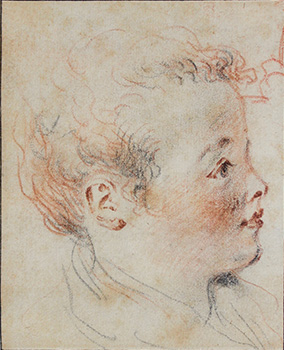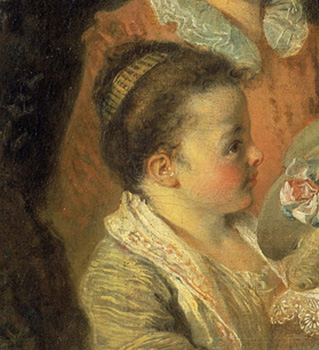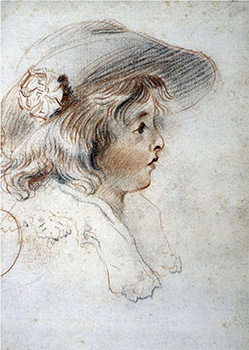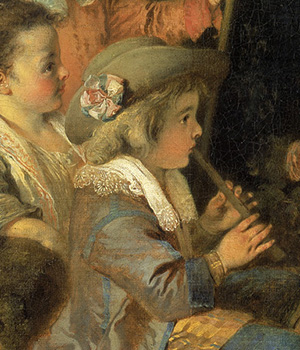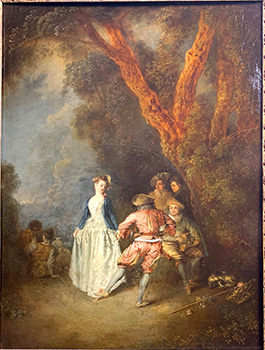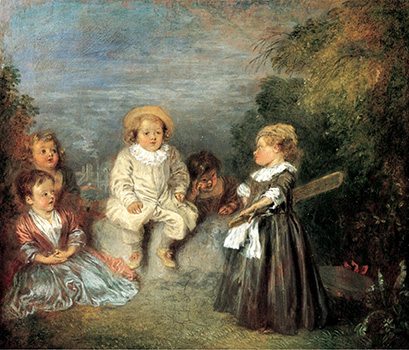
- Home Page
- Accepted
Paintings & Copies - Doubtful
Attributions - Doubtful Textual References
- Alternative
Titles - Collectors &
Museums - Bibliography
- Search Abecedario
- Watteau &
His Circle
Iris, c’est de bonne heure
Entered March 2024
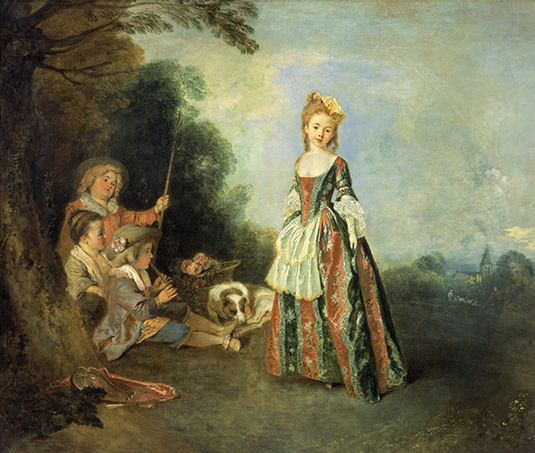
Berlin, Gemäldegalerie Staatliche Museen Preussischer Kulturbesitz, inv. Mü 3644
Oil on canvas
97 x 116 cm (originally 92 x 94 or 96 cm)
ALTERNATIVE TITLES
The Dance
La Danse
La Danza
Der Tanz
Une Petite danceuse
Les Plaisirs de la jeunesse
RELATED PRINTS
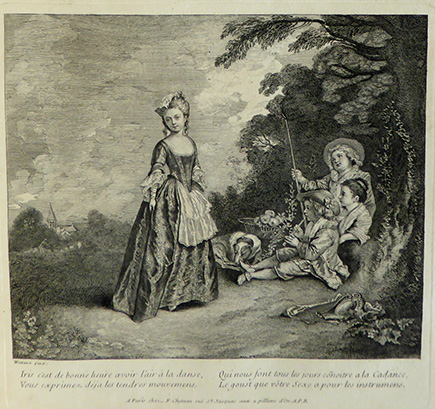
Watteau’s Iris c’est de bonne heure was engraved in reverse by Charles Nicolas Cochin prior to 1729. It was one of ten engravings commissioned by Pierre Sirois.
PROVENANCE
Paris, unknown collection.
Acquired for the collection of Frederick the Great (1712-1786), or for his younger brother Henry (1726-1802). It was listed in the inventory of the latter’s estate in 1810.
Berlin, in the Old Palace, c. 1875. According to Goncourt, it was in the “chambre de parade, Salon Vert." It later was moved to the Neues Palais, Potsdam, and after World War I, in 1926, it was returned to the Hohenzollern family.
Silesia, Chateau d'Oels, sale, collection of the Hohenzollern family collection, 1927.
Switzerland, with Hugo Moser (1882-1972; art dealer); moved to New York in 1933; offered the picture at an unspecified sale.
Acquired in 1942 for the museum Hitler planned to build in Linz, Austria.
Munich after 1945, with the Treuhand Verwaltung fur Kulturgut.
Berlin, Gemäldegalerie, deposited there in 1952 by the Federal Republic of Germany.
EXHIBITIONS
Berlin, Königliches Akademie der Künste, Gemälde älterer Meister (1883), cat. 5 (as by Watteau, Der Tanz, lent by the Kaiser).
Paris, Exposition universelle, Frédéric le Grand (ed. P. Seidel) (1900) 18, 20, cat. 31 (as by Watteau, La Danse).
Berlin, Königliches Akademie der Künste (1910), cat. 75 (as by Watteau, Der Tanz, leny by the Kaiser).
London, Royal Academy, Exhibition of French Art (1932), cat. 167 (as by Watteau, La Danse, lent by Hugo Moser
Berlin, Dahlem Museum, Meisterwerke aus den Berliner Museen (1953), cat. 92 (as by Watteau, Der Tanz).
Potsdam, Schloss Charlottenburg, Meisterwerke aus den Schlössern Friedrichs des Grossen (1962), cat. 98 (as by Watteau, Der Tanz).
Paris, Louvre, La Peinture française du XVIIIe siècle à la cour de Frédéric II (1963), cat. 38 (as by Watteau, La Danse).
Dusseldorf, Städtische Kunsthalle, Preussische Kulturbeistz (1967), cat. 221 (as by Watteau, Der Tanz, lent by Preussicher Kulturbesitz, Leihgabe des Bundes).
London, Royal Academy, France in the Eighteenth Century (1968), cat. 725 (as by Watteau, The Dance, lent by the Government of the Federal Republic of Germany).
Braunschweig, Anton Ulrich-Museum, Französische Malerei von Watteau bis Renoir (1983), 100-02, cat. 36 (as by Watteau, Der Tanz [Iris], lent by Gemäldegalerie, Berlin).
Washington, Paris, and Berlin, National Gallery of Art (1984), Watteau 1684-1721, cat. 72 (as by Watteau, Iris (The Dance) (Iris, c’est de bonne heure), lent by the Gemäldegalerie, Staatliche Museen Preussischer Kulturbesitz, Berlin).
Ottawa, National Gallery, Age of Watteau, Chardin, and Fragonard (2003), cat. 11 (as by Watteau, Iris (The Dance), lent by the Staatliche Museen zu Berlin, Gemäldegalerie).
SELECT BIBLIOGRAPHY
Mariette, "Notes manuscrites," 9: fol. 191.
Goncourt, L'Art au XVIIIème siècle (1860), 58.
Cellier, Watteau (1867), 89.
Goncourt, Catalogue raisonné (1875), cat. 175.
Dohme, "Zur Literatur über Antoine Watteau" (1876), 90.
Dohme, Kunst und Künstler (1880), 17.
Mollet, Watteau (1883), 72.
Dohme, "Die Französische Schule des XVIII. Jahrhunderts" (1883), 240.
Rosenberg, "Die Ausstellung von Werken" (1883), 359.
Ephrussi, "Exposition d'œuvres de maîtres anciens" (1884), 102.
Mantz, "Watteau" (1890), 232.
Mantz, Watteau (1892), 186.
Seidel, Friedrich der Große und die französische Malerei (1892), 34-35, 68.
Phillips, Watteau (1895), 56, 58.
Rosenberg, Watteau (1896), 73.
Dilke, French Painters (1899), 90.
Fourcaud, "Potsdam à Paris" (1900), 271-72.
Lafenestre, "La Peinture ancienne" (1900), 554.
Seidel, Collections d'oeuvres d'art françaises (1900), 147, cat. 156.
Staley, Watteau (1902), 70.
Josz, Watteau (1903), 378.
Fourcaud, "The German Emperor's Collection of French Paintings" (1904), 56.
Josz, Watteau (1904), 166, 221.
Seidel, Gemälde alter Meister (1906), 134-35.
Meier-Graefe, "Correspondance d'Allemagne" (1910), 263.
Mourey "Une Exposition d'art français du XVIIIe siècle" (1910), 572, 577-78.
Vaudoyer, "Exposition d'oeuvres de l'art français" (1910), 17.
Hourticq, Geschichte der Kunst in Frankreich (1912), 253.
Pilon, Watteau et son école (1912), 102, 104, 113-14, 150, 201.
Zimmermann, Watteau (1912), pl. 93-95, 179.
Maurel, L'Enseigne de Gersaint (1913), 2, 19.
Bouyer, "La Question des oeuvres d'art" (1919), 426-27, 435.
Maurel, "Les Collections d'art français de Guillaume II" (1919), 23, 26.
Dacier, Vuaflart, and Hérold, Jean de Jullienne et les graveurs (1921-29), 1: 37, 261; 2: 22, 31, 65-66, 91-92, 100, 131, 151; 3: 40, 136, cat. 76.
Seidel, Friedrich der Große und die bildende Kunst (1922), 132.
Gesetz über die Vermögensauseinandersetzung (1926), 279.
Réau, "Watteau" (1928), cat. 110.
Wilenski, French Painting (1931), 108, 115.
Borenius, "Die französische Ausstellung in London" (1932), 91.
Van Puyvelde-Lassalle, Watteau et Rubens (1943), 16.
Adhémar, Watteau (1950), 140-41, cat. 208.
Thornton, Baroque and Rococo Silks (1965), 107, 168.
Macchia and Montagni, L'opera completa di Watteau (1968), cat. 200.
Ferré, Watteau (1972), cat. B 39.
Boerlin-Brodbeck, Watteau und das Theater (1973), 168, 207, 331.
Wilenski, French Painting (1973), 100.
Roland Michel, Watteau (1981), cat. 246.
Roland Michel, Watteau (1984), 210, 218, 220, 273.
Posner, Watteau (1984), 167, 201, 245, 247.
Börsch-Supan, "Frederick the Great and Watteau" (1984), 546.
Sande, Rheinsberg, Eine Märkische Residenz (1985), 75, 81.
Bock, Gemäldegalerie Berlin (1985), 400-01.
Roland Michel, "Watteau and England" (1986), 46-59.
Uhlitz, "Friedrich der Große, Watteau" (1986), 9-10, 13, 16, 19, 24, 26-27.
Deslandres, "Watteau peintre du costume de son temps" (1987), 247.
Grasselli, Drawings of Watteau (1987), 184, 395-96.
Allen, "Watteau and his Imitators" (1987), 259.
Edwards, "Watteau and the Dance" (1987), 220.
Rosenberg and Prat, Watteau, Catalogue raisonné des dessins (1996), cat. 364, 413, 425, 570.
Börsch-Supan, Watteau (2000), 119, 121.
Göres, Sommer, and Fuchs, Prinz Heinrich Von Preussen (2002), 422.
Temperini, Watteau (2002), 125, cat. 108.
Toom, "Das Museum Haus Doorn" (2003), 12.
Rosenberg, Gesamtverzeichnis französische Gemälde (2005), 206-07.
Toffolo, Le Feste galanti (2005),36-37.
Siegfried, "Femininity and the Hybridity of Genre Painting" (2007), 25.
Michel, Le «célèbre Watteau» (2008), 19-20, 259.
Lauterbach, Watteau (2008), 71.
Glorieux, Watteau (2011), 327.
Milam, Historical Dictionary of Rococo Art (2011), 268.
Vogtherr, Französische Gemälde (2011), cat. B 3
RELATED DRAWINGS
Several drawings are related to Iris, c'est de bonne heure—all studies for the heads of the four children.
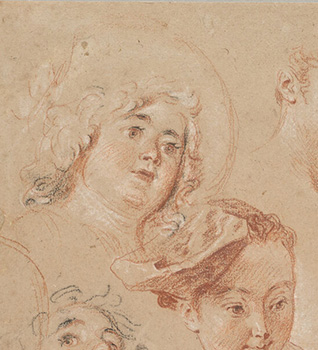
Watteau, Six Studies of Heads (detail), red, black, and white chalk. Cambridge, MA, Fogg Art Museum, bequest of Meta and Paul J. Sachs.
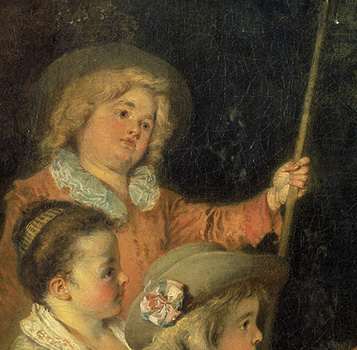
Watteau, Iris, c'est de bonne heure (detail).
The head of a wistful young boy at the top left corner of a sheet in the Fogg Art Museum with six such studies of children (Rosenberg and Prat 413) served for the head of the standing boy in the painting.
A drawing in Los Angeles (Rosenberg and Prat 570) was used for the young girl seated on the ground in Iris, c'est de bonne heure. Although the drawing shows only this head, it seems to have been cut from a larger sheet, one that may originally have included other such studies, like the sheet in the Fogg Art Museum.
Last, the young flutist in the painting seems to have been based on a charming drawing in the Musée Cognac-Jay, Paris (Rosenberg and Prat 364 ). Although the details of his hat were fully rendered in the drawing, there is no flute. An early twentieth-century photograph of the drawing shows that at one point a faintly sketched flute was positioned at his lips; however, that flute was inorganically joined to his mouth, and was probably, rightfully, removed in the course of a subsequent cleaning.
Strikingly absent from this group are drawings that show the children's' full bodies. Might Watteau have used drawings of adults that he already had on hand and then reduced them to infantile scale? Iris's pose, for example, resembles in reverse that of the central actress in Les Habits sont italiens. Or, more likely, did he draw full-length studies of the children—none of which have come down to us? This is an intriguing question that, at least for the present, cannot be answered.
REMARKS
Iris, c'est de bonne heure is one of several pictures that Watteau painted where children assume adult roles and display adult emotions. Its basic composition can be favorably compared with other, well-known fêtes galantes such as La Danse paysanne. There, as in Iris, c'est de bonne heure, a woman spreads her skirt outward and assumes a dance position, and she is accompanied by a musician and onlookers as well as a sleeping dog. The idea of children taking adult roles was something that the artist explored in other paintings, such as Heureux age! Age d'or. In short, although an exceptional and beautiful work, Iris, c'est de bonne heure fits comfortably within the canon of Watteau's paintings.
All Watteau scholars agree that the painting is one of the artist's mature works and they generally place it somewhere between 1718 and 1720. Many contemporary scholars believe it was executed between September 1719 and August 1720, that is, when Watteau was living in London.
Several factors have been cited to support the idea that the painting was created in London. One theory focuses on Iris' dress and its embroidered floral stripes. Analysis of the underpainting shows that originally the cloth was plain and undecorated. Indeed, this element of fashion is unique in the artist's oeuvre: nowhere else did he render patterned textiles. Peter Thornton compared the pattern to a Spitalfields silk, but Aileen Ribeiro (as conveyed by Vogtherr) has challenged this association, claiming that the pattern is also similar to Continental textiles of comparable date.
Various technical analyses—x-rays and spectrographs—have revealed that although the painting today is rectangular, corresponding to the format it had when it was engraved c. 1729, in an anterior state its corners were rounded. Apparently, it started life as a slightly smaller, oval canvas. Vogtherr cites measurements of 92 by 94 or 96 cm. Then, presumably while still in Watteau's studio, that painted canvas was removed from its stretchers and pasted down onto a fresh rectangular canvas. The corners of the new canvas were painted in, and some of the existing elements from the old canvas—such as the tree branch—were extended down into the preexistent sections. The girl at the left, to cite another instance, now convincingly leans against a tree stump, but she had no such support in the original canvas. These changes were skillfully executed and are not readily apparent today.
Vogtherr has reasonably argued that such oval-format pictures were often destined for overdoors, and he posited that this perhaps was the original intent for Iris, c'est de bonne heure. But if this work was painted in England, was it for a French or English house? And how does this fit with the painting being engraved in Paris? These narratives, rather than supporting each other, seem contradictory.
For copies of Iris, c'est de bonne heure, CLICK HERE
